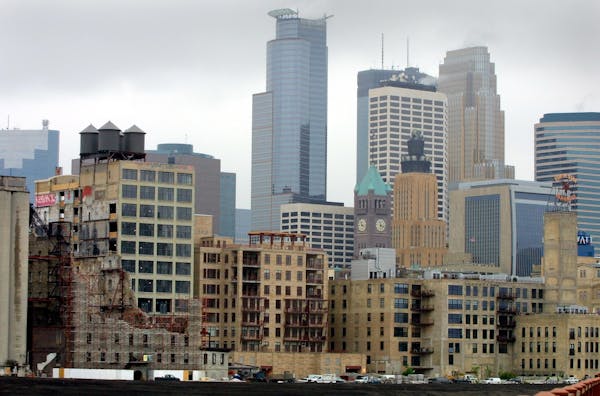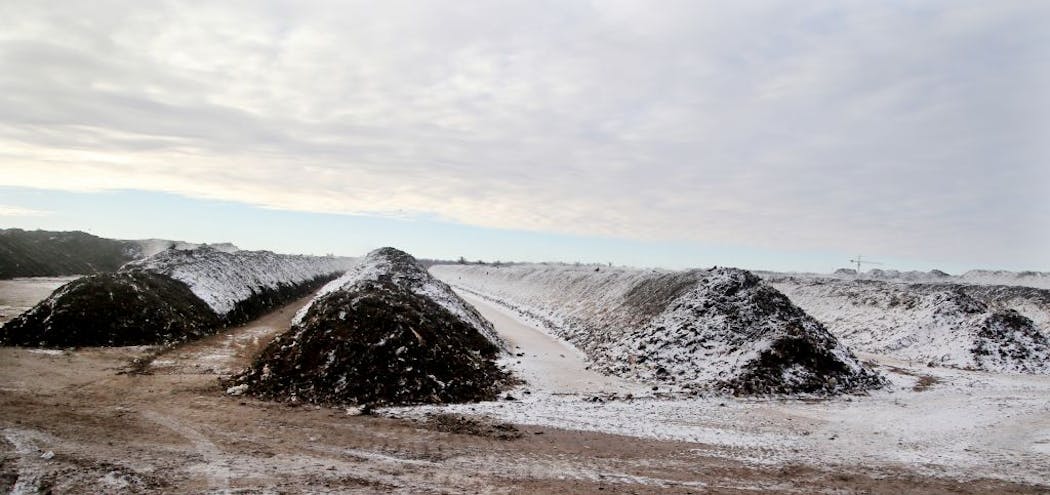How do food scraps get recycled in Minnesota — and how good are we at it?
Listen and subscribe to our podcast: Via Apple Podcasts | Spotify | Stitcher
Annie Jacobsen's family has been talking a lot about trash since she embarked on a journey to reduce her household's waste.
Her daughters have plenty of questions, for example, about what's allowed in the smaller trash bin destined for composting through Minneapolis' organics recycling program.
"We talk a lot about what happens when we put things in the trash," Jacobsen said. "And...what does it mean that we can recycle our organics? And what does the city do with them?"
Jacobsen and her daughter Florence, 6, sought answers about how large-scale composting works from Curious Minnesota, a Star Tribune reporting project fueled by great questions from inquisitive readers.
The topic is particularly relevant these days as organics recycling programs blossom across Minnesota. Residents can now recycle food scraps at the curb in more than 40 cities, either in an organics bin or special bags tossed in the trash — which are later removed. Still other areas have organics drop-off sites or allow haulers that may offer the service.
Pigs are still the largest consumer of our food scraps in Minnesota, though not from residential programs. Nearly 200,000 tons of Minnesota's food waste was fed to livestock in 2018, based on the latest figures from the Minnesota Pollution Control Agency. A lot of that food came from businesses like restaurants and grocery stores.
But another 100,000 tons of organic waste was sent to composting facilities — 27% more than the previous year. Not including yard waste, Minneapolis residents alone recycled enough food scraps and compostable material to fill a hockey rink above the brim of the plexiglass, the city estimates. All that wet stuff would have otherwise been fed into a giant fire at Hennepin County's garbage incinerator in downtown Minneapolis.
Many people are familiar with the mechanics of backyard compost piles. But turning tons of food scraps into nutrient-rich soil requires a special facility, and there are only two major ones in the metro area. Here's how it works.
The pad
It begins with the "pad." State rules require large-scale compost sites to have underground clay liners protecting groundwater from the liquid that seeps through the pile of waste — similar to what's found beneath landfills. The pad is one of the most expensive aspects of a composting facility.
'Giant hot tub' mixer
Minneapolis' organic waste goes to a site in Rosemount operated by Specialized Environmental Technologies.
General Manager Ken Tritz said workers first combine the food scraps and yard waste — which contains more carbon — in a giant mixer that looks like a "big giant hot tub." The mixture is approximately 50/50, though wet food waste requires an extra dose of yard waste.
"It's almost like being a chef. You just kind of go with what the consistency is on the material," Tritz said.
Microorganism mealtime
Once the material is combined, workers then spread it into long piles — known as "windrows" — atop hole-filled tubes. A powerful fan blows air into the tubes, supplying microorganisms in the pile with needed oxygen as they feast away at the waste.
Without that air, the microorganisms would be unable to do their job.
"The pile would just sit there and once you ... break into it, it would stink pretty bad," Tritz said. "Because basically it would be rotting garbage at that point."
Killing pathogens
All this microbial activity in the pile generates a lot of heat. Tritz said the temperature inside the windrows reaches more than 140 degrees. During the winter months, steam billows out as workers open up the finished piles.
"We've actually had people call thinking that our site was on fire," Tritz said. To kill pathogens, the windrow must remain above 131 degrees for five days. But Tritz said the piles often sit for 45 to 60 days, depending on space constraints.
Giant tumblers
The compost then goes through a spin cycle in 20- to 30-foot tumblers with screens that sort larger, non-compostable items from finished compost. Contaminants include items like plastic bags and recyclable bottles, Tritz said.
Generally loads coming from businesses contain more non-compostable items, Tritz said. Click for an overview of what's compostable at sites like SET.
The final product
Tritz said they sell compost largely to contractors and landscapers. A lot of it is used in roadway projects, but it is also incorporated into large building projects like the Amazon fulfillment center in Shakopee.
"We've been lucky every year so far to find a big job that can use up the stuff, but as more [organics] programs come on that's going to be challenging," Tritz said.
SET's composting process is slightly different from the metro area's other major organics site, operated by the Shakopee Mdewakanton Sioux Community. Rather than blowing air into the pile, workers there drive a special arched machine over the windrows to turn them once a week.
How are we doing?
Jacobsen isn't the first reader to ask Curious Minnesota about organics recycling. Others have wanted to know how well Minneapolis does at composting its food scraps.
Minneapolis' program, which launched in 2015, is considered one of the best in the nation. Roughly half the households served by the city's waste service have now signed up. The contamination rate, a measure of non-compostable items in the stream, is less than 1%.
"Folks from other communities in the country do not believe that is possible," said Kellie Kish, the city's recycling coordinator.
The U.S. Composting Council, based in North Carolina, named Minneapolis "Organics Diversion Program of the Year" in 2018. Executive Director Frank Franciosi credited the city's extensive outreach process, which has included advertising, direct mail, sponsored events and targeted door-knocking. Crews also leave educational tags on carts if people aren't using them correctly.
"We probably will use it as a case study on how to set up a curbside collection program," said Franciosi."They did a really big outreach program up front. And then they rolled it out," Franciosi said. "A lot of programs, they kind of skip that step. And that's probably the most important step."
---
If you'd like to submit a Curious Minnesota question, fill out the form below:
Read more Curious Minnesota stories:
Why is Minnesota more liberal than its neighboring states?
When you flush a toilet in the Twin Cities, where does everything go?
Was Minnesota home to nuclear missiles during the Cold War?
How did Minnesota become known as the 'Land of 10,000 Lakes?
Why does Minnesota have one of highest rates of volunteering in the U.S.?
What's the truth behind Minnesota's Kensington Runestone?
St. Paul vs. Minneapolis: Why can't the Twin Cities get along?
Are Minnesota's day-care costs really the highest in the nation?
When did wild bison disappear from Minnesota?
Does Minnesota really have the worst winters in the country?
![Patrons left Surly on Saturday, August 1, 2015. ] Aaron Lavinsky ¥ aaron.lavinsky@startribune.com Restaurant review: Surly Brewing's casual beer hall](https://arc.stimg.co/startribunemedia/MZVOQDYMULLWEBJK4RYIM2UDUE.jpg?w=600&h=600&auto=format%2Ccompress&cs=tinysrgb)



